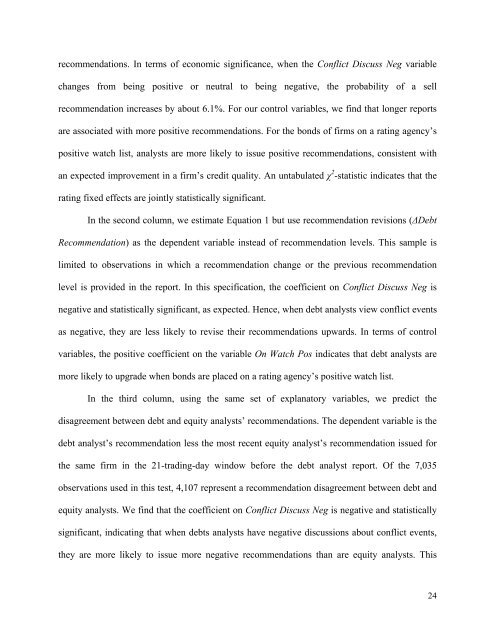Debt Analysts' Views of Debt-Equity Conflicts of Interest
Debt Analysts' Views of Debt-Equity Conflicts of Interest
Debt Analysts' Views of Debt-Equity Conflicts of Interest
You also want an ePaper? Increase the reach of your titles
YUMPU automatically turns print PDFs into web optimized ePapers that Google loves.
ecommendations. In terms <strong>of</strong> economic significance, when the Conflict Discuss Neg variable<br />
changes from being positive or neutral to being negative, the probability <strong>of</strong> a sell<br />
recommendation increases by about 6.1%. For our control variables, we find that longer reports<br />
are associated with more positive recommendations. For the bonds <strong>of</strong> firms on a rating agency’s<br />
positive watch list, analysts are more likely to issue positive recommendations, consistent with<br />
an expected improvement in a firm’s credit quality. An untabulated χ 2 -statistic indicates that the<br />
rating fixed effects are jointly statistically significant.<br />
In the second column, we estimate Equation 1 but use recommendation revisions (Δ<strong>Debt</strong><br />
Recommendation) as the dependent variable instead <strong>of</strong> recommendation levels. This sample is<br />
limited to observations in which a recommendation change or the previous recommendation<br />
level is provided in the report. In this specification, the coefficient on Conflict Discuss Neg is<br />
negative and statistically significant, as expected. Hence, when debt analysts view conflict events<br />
as negative, they are less likely to revise their recommendations upwards. In terms <strong>of</strong> control<br />
variables, the positive coefficient on the variable On Watch Pos indicates that debt analysts are<br />
more likely to upgrade when bonds are placed on a rating agency’s positive watch list.<br />
In the third column, using the same set <strong>of</strong> explanatory variables, we predict the<br />
disagreement between debt and equity analysts’ recommendations. The dependent variable is the<br />
debt analyst’s recommendation less the most recent equity analyst’s recommendation issued for<br />
the same firm in the 21-trading-day window before the debt analyst report. Of the 7,035<br />
observations used in this test, 4,107 represent a recommendation disagreement between debt and<br />
equity analysts. We find that the coefficient on Conflict Discuss Neg is negative and statistically<br />
significant, indicating that when debts analysts have negative discussions about conflict events,<br />
they are more likely to issue more negative recommendations than are equity analysts. This<br />
24
















